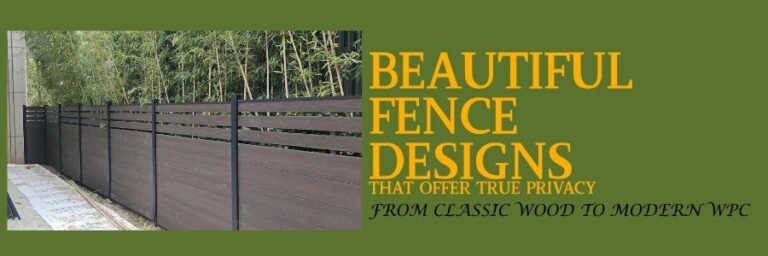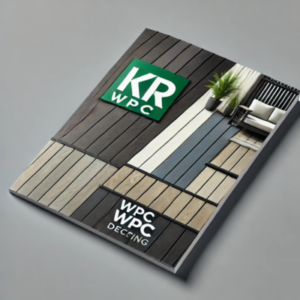You look out at the yard and picture a peaceful, private space—kids safe, dog happy, curb appeal on point. Then the calculator pops up in your head. How much is this fence going to set you back in 2025? Let’s unpack it together, coffee in hand. Running late, the idea still stuck: when you understand what drives cost—materials, labor, design choices—you can nudge the numbers where you want them.
Below is a friendly, plain‑English guide to the real costs, what makes them rise (or fall), and how to plan smart—especially if you’re considering low‑maintenance composite wood Fence (wood‑plastic composite) options like KR WPC.

Why Fence Installation Costs Vary
- Fencing as both a functional and aesthetic investment
A fence is part safety feature, part outdoor architecture. The same way a sofa anchors a living room, your fence frames your property. So the “right” price is partly about function (keep kids/pets in, strangers out) and partly about the look you want from the street. - Why installation cost is not one-size-fits-all
Costs swing with material, height, length, layout, and local labor. National averages help with ballparks, but the spread is wide. Recent national guides put typical fence projects around the low‑to‑mid $3,000s, with many homeowners landing between roughly $1,800 and $4,800—and outliers on either side depending on scope and style. - How KR WPC helps homeowners plan smartly for fencing budgets
Modular composite systems like KR WPC let you mix panel heights, standardize spans, and reduce maintenance line items (no painting, staining, or sealing). That predictability helps you build a cleaner, more realistic budget from day one. (Internal link)
Understanding the Key Components of Fence Installation Costs
Material Costs
- Breakdown: wood, vinyl, metal, and WPC composite fencing
Material choice is the biggest driver. On a per‑linear‑foot installed basis, recent cost studies show:- Wood: commonly about $15–$35/ft installed
- Vinyl (PVC): about $15–$40/ft installed
- Composite (WPC): about $22–$40/ft installed
- Chain link: about $12–$40/ft installed (varies with height/finish)
- Aluminum/steel ornamental: roughly $15–$60/ft installed
Installed ranges reflect both material grade and the labor to put it together.
- Why composite fences, though higher upfront, save over time
WPC sits above basic wood on initial cost but avoids the regular staining/painting cycle and resists rot and warping. Over 10 years, that “no finish needed” line item often erases the gap. More on that in the comparison section. For context, many composite systems carry long residential warranties—25 years isn’t unusual.
Labor Costs
- Average price ranges and what affects installation fees
Labor often accounts for about half the total project cost, though it varies with material and site complexity. A current national guide pegs labor at roughly 50% on average. By material, labor commonly runs about $13–$15/ft for composite, $10–$20/ft for wood, and $5–$10/ft for vinyl/aluminum. - DIY vs. professional installation: pros and cons
Pros move quickly, have the tools, and understand codes/setbacks, saving you from rework. DIY can cut a big chunk of labor—one national guide estimates homeowners save around $1,700 on average—but expect heavy digging, precise layout, and permit runs.
Additional Expenses
- Posts, fasteners, gates, and finishing details
Gates add hardware and hinges; plan from $150 per opening and up. Decorative caps, concrete, and premium hardware add polish—and dollars. - Site preparation, leveling, and disposal of old fencing
Removing an old fence often runs $3–$5/ft. Land leveling, root/rock hassles, and utility work can push totals higher; budget for those if your yard isn’t straightforward.
How Different Fence Materials Impact Total Cost
Wood Fences
Lower upfront, higher maintenance. You’ll love the warmth and flexibility (and your neighbors likely will too), but wood asks for regular care. Expect periodic sealing or staining; professional painting/staining commonly runs in the range of about $3.50–$13/ft when you outsource it. Over time, that adds up—even if the starting price was friendly.
Vinyl Fences
Clean look, decent range of styles, and very steady on maintenance. Installers need to be precise—panels and posts must align perfectly—but day‑to‑day care is basically a hose and a soft brush. Pricing usually sits mid‑pack.
Metal Fences
Durable and striking (especially wrought iron/steel), but typically pricier in both material and skilled labor. Aluminum can lower cost/maintenance versus steel or iron, while still delivering that elegant, open look.
WPC Composite Fences (KR WPC Focus)
Mid‑range installation cost, minimal maintenance, excellent lifespan. Composite pairs the wood look with skip‑the‑paint practicality. Many brands back privacy fence systems with 25‑year residential warranties, so you’re not babysitting finish schedules. That long‑view performance is where WPC shines.
Long‑term savings due to resistance to rot, insects, and warping. You’re basically paying more on day one to avoid the scheduled maintenance treadmill. Crazy, right?

Factors That Influence Your Fence Installation Price
- Fence Height and Length
More linear feet = more posts, panels, and labor. Most cost charts scale fairly linearly by foot, so accurate measurements are your wallet’s best friend. - Terrain and Soil Condition
Slopes, clay, rock, and tree roots mean deeper holes, more concrete, and potentially special equipment—i.e., more labor. If you’re replacing an old fence, count the removal. - Design Complexity
Decorative tops, horizontal slats, custom colors, and integrated screens look amazing yet take longer to install. Precision cuts and extra hardware drive labor. - Regional Labor Rates
Urban markets tend to run hotter than rural. Recent city snapshots show higher averages in places like Los Angeles and Seattle than in Orlando or St. Louis. - Permits and Local Regulations
Some municipalities require a permit or inspection; costs vary but $20–$60 is a common bracket in many areas. Check setback and height rules before you order.
Cost Comparison: WPC Fence vs. Other Fencing Types
To make this practical, let’s compare a 200‑foot project at common heights and styles (privacy for WPC and wood; standard panel styles for vinyl and metal). We’ll use 2025 national ranges and simple, defensible maintenance assumptions.
- Initial installation (national ranges, 2025):
- WPC composite: ~$22–$40/ft → $4,400–$8,000
- Wood privacy: ~$15–$35/ft → $3,000–$7,000
- Vinyl: ~$15–$40/ft → $3,000–$8,000
- Ornamental metal (aluminum/steel blend): ~$15–$60/ft → $3,000–$12,000
Sources synthesize current national cost guides.
- 10‑year maintenance snapshot (estimates)
- Wood: pro stain/paint every ~3–4 years; assume three cycles in 10 years at, say, $3.50–$13/ft each → about $2,100–$7,800 on 200 ft.
- Vinyl: wash only → minimal cost (DIY).
- WPC composite: wash only → minimal cost (DIY).
- Metal: touch‑up coatings or rust treatment as needed (varies; aluminum is lower).
- Overall value picture
Wood may start cheaper but inches up with finishing; WPC and vinyl hold steady, and metal sits at the higher end for most decorative projects. Many composite systems are warrantied 25 years for residential use, lining up with that lower maintenance profile.
Tips to Save on Fence Installation
1) Combine DIY with professional setup
Let pros handle posts, gates, and permits. You attach panels or slats. This hybrid approach keeps quality high and labor hours down.
2) Choose modular WPC fencing systems for faster installation
Composite panels + standardized spans speed things up on site and keep cut waste low—time is money. KR WPC offers modular boards and trims that make clean corners and step‑downs easier. (Internal link)
3) Schedule installation off‑season to reduce labor fees
Late fall or winter bookings can open up schedules; some contractors sharpen their pencil to fill the calendar. No guarantee, but worth asking.
4) Plan accurate measurements to avoid material waste
Measure twice, order once. And mark utilities. Over‑ordering by “just in case” numbers can quietly add hundreds. A simple sketch with panel counts and gate widths pays for itself.
5) Get two to three itemized quotes
Ask each pro to break out materials, labor, haul‑away, gates, and concrete. You’ll spot apples‑to‑apples differences immediately. As one contractor notes, pricing can shift by company, especially based on what they buy in volume.
“It depends on the company you hire… their pricing for materials might change a bit depending on the volume they order.”

Conclusion
You’ve got choices. Lots of them. The trick isn’t hunting for the single “right” number—it’s matching your goals with a material and layout that fit your budget now and your time later. If you’d rather relax on weekends than wrangle stain and a brush, WPC composite delivers a sweet spot of cost, durability, and style that stays sharp year after year. And when you choose a trusted wpc fencing manufacturer like KR WPC, you get more than just panels—you get a modular approach, clean lines, and a low‑maintenance finish designed to last. Your fence can be the backdrop—not the project list—for the next decade. Picture it: sunlight on a modern, straight fence line, dog snoozing in the shade, your Saturday blissfully unbooked.
FAQ
Q: How much does it cost to install a WPC fence per foot?
A: National 2025 ranges commonly land around $22–$40 per linear foot installed, depending on height, style, and local labor. Premium designs, wind kits, or custom gates can push higher; simpler runs can be lower.
Q: What’s the average labor cost for fence installation?
A: Labor frequently represents about half of a project’s total. By material, expect rough averages like $13–$15/ft for composite, $10–$20/ft for wood, and $5–$10/ft for vinyl or aluminum. Your site and city will nudge those numbers up or down.
Q: How long does a WPC fence last compared to other types?
A: Many composite systems carry 25‑year residential warranties, aligning with a long service life and minimal upkeep. Vinyl can also last decades with simple cleaning. Wood’s lifespan varies widely with species and maintenance.
Q: What factors increase fence installation costs?
A: Height/length, challenging terrain (slopes, rocks, roots), gate count, ornate designs, and local labor rates. Permits, haul‑away, and grading can add line items, too.
Q: Can I install a composite fence myself to save money?
A: If you’re comfortable setting posts dead‑plumb and handling concrete, you can save a chunk of labor—one national analysis suggests DIY can cut around $1,700 on average. Many homeowners still hire pros for posts and gates, then complete panel infill themselves.








